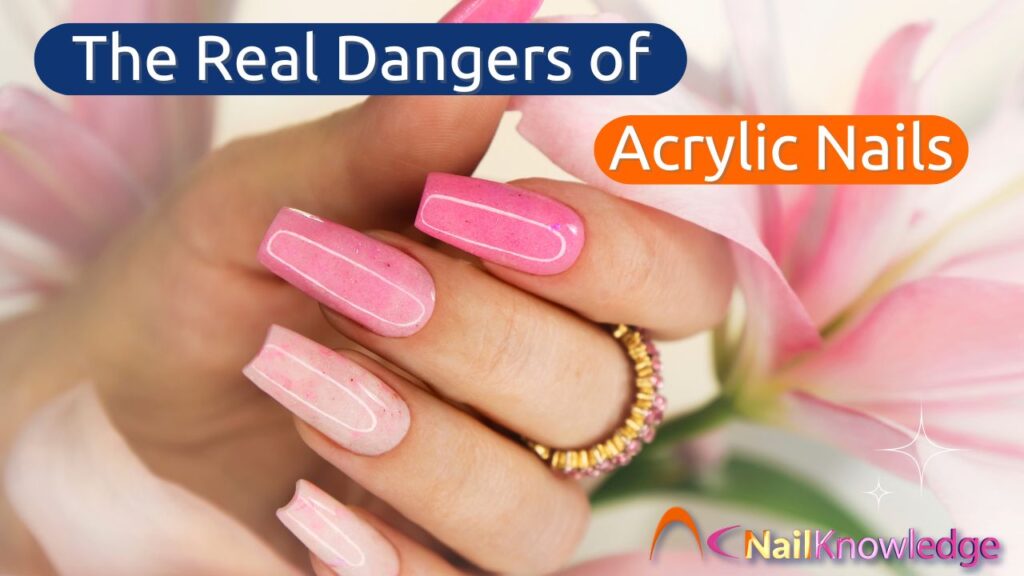Những gì khoa học mới nhất cho chúng ta biết
There’s something undeniably satisfying about a fresh set of acrylics. The glossy finish, the perfect length, the instant confidence boost, it’s easy to see why they’re a go-to for so many. But new research is prompting an important question: are we fully aware of the potential risks behind those polished tips? According to recent findings from the University of Nevada, Reno, the dangers of acrylic nails go beyond the usual wear and tear, and it’s time we had an honest conversation about it.
🧪 What’s New in the Science of Acrylic Nails?
Acrylic enhancements (all enhancements that need to cure with either a UV LED lamp or air dry as L&P) have long been a staple in nail salons, celebrated for their durability and aesthetic appeal. However, this new study dives into the less glamorous side, specifically, the chemical compounds released during application and wear. Các nhà nghiên cứu highlighted concerns over substances like methyl methacrylate (MMA), toluene, and formaldehyde resin. These aren’t new names in the beauty world, but their impact is becoming clearer as our understanding of toxicology evolves.
Theo nghiên cứu, việc tiếp xúc nhiều lần với một số hơi nước and dust created during filing or curing can lead to respiratory irritation, skin sensitivity, and, in some cases, more serious systemic effects. Now, does this mean acrylics are inherently dangerous? Not quite—but it does mean we need to get smarter about how and when they’re used.
💬 Một chiếc đinhKiến thức: Khoa học nên định hình thực hành
At NailKnowledge, we’ve always advocated for education-first practices. The beauty industry moves fast, but we believe science should move faster. These findings don’t mean a full stop on acrylics—but they do call for a fresh look at safety standards, product choices, and client communication.
Đối với các chuyên gia, đây là lời nhắc nhở:
- Chọn các giải pháp thay thế an toàn hơn cho các hóa chất có nguy cơ cao (tránh võ thuật hỗn hợp at all costs, it’s banned in many places for a reason).
- Đảm bảo tiệm của bạn có hệ thống thông gió hiệu quả.
- Use proper PPE when filing or removing acrylics, especially during high-dust procedures.
- Keep up with Material Safety Data Sheets (MSDS) and manufacturer updates.
For clients, it’s about informed choices. Ask questions. Understand what’s being applied to your nails. If your technician can’t tell you what’s in the products they’re using, that’s a red flag.
🔍 Hiểu về mối nguy hiểm thực sự của móng Acrylic
One of the most compelling points in the University of Nevada study was around cumulative exposure. While a single acrylic application likely won’t cause harm, it’s the repeated and prolonged exposure, particularly in poorly ventilated salons, that raises concerns. Imagine it like a dripping tap. One drop? Not a problem. But over time, that constant drip fills a bucket and potentially overflows.
And it’s not just about clients. Nail techs are on the frontlines of this exposure daily. This is why updated education and rigorous health standards are non-negotiable in our industry.
🔄 Cùng nhau cập nhật kiến thức của chúng ta
We’re not here to sensationalise, we’re here to support. As new research emerges, so do better practices. That’s why we’re reviewing older NailKnowledge articles and updating where necessary. If past guidance no longer reflects current science, we’ll flag it. Transparency isn’t a trend, it’s a responsibility.
🧠 Vậy, bạn nên làm gì?
If you’re a nail pro:
- Stay current with ingredient safety. Don’t assume a product is safe just because it’s on the shelf.
- Ưu tiên giáo dục cho bản thân và khách hàng của bạn. Nhận thức dẫn đến kết quả an toàn hơn.
- Ủng hộ việc cải thiện các quy trình an toàn tại nơi làm việc của bạn.
If you’re a client:
- Don’t be afraid to ask your technician about the products being used.
- Hãy tìm những tiệm coi trọng vấn đề vệ sinh, thông gió và tính minh bạch.
- Pay attention to how your nails and skin react, your body often tells you when something’s not right.
🗣 Editor’s Note (April 2025)
Bài viết này đã được cập nhật để phản ánh nghiên cứu mới về rủi ro tiếp xúc hóa chất của móng acrylic. NailKnowledge vẫn cam kết giáo dục dựa trên bằng chứng và khuyến khích cộng đồng của chúng tôi luôn cập nhật thông tin khi khoa học phát triển.
📢 Chúng tôi muốn nghe từ bạn
Have a question about this new research? Or think we need to re-evaluate a past recommendation? Email us at [email protected] We’re building a community of learners, not know-it-alls.
Vào cuối ngày, móng tay không bao giờ nên đánh đổi bằng sức khỏe. Những nguy hiểm của móng acrylic là có thật, nhưng có thể kiểm soát được. Acrylic hoàn toàn có thể có một vị trí trong thời hiện đại chăm sóc móng tay, when we use them wisely, with a full understanding of what’s involved


